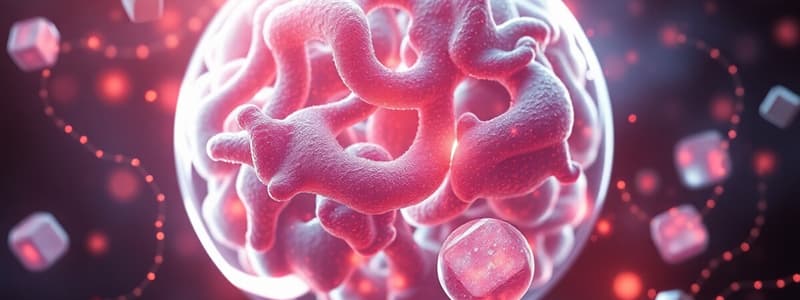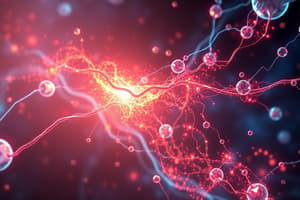Podcast
Questions and Answers
Why might a high-protein meal interfere with the effectiveness of levodopa in managing Parkinson's disease symptoms?
Why might a high-protein meal interfere with the effectiveness of levodopa in managing Parkinson's disease symptoms?
- High-protein meals accelerate the breakdown of dopamine in the synapse, diminishing levodopa's benefit.
- High-protein meals increase the metabolism of levodopa in the liver, reducing its bioavailability.
- Protein directly inhibits dopamine synthesis in the striatum, counteracting levodopa's effects.
- Amino acids from protein compete with levodopa for transport across the blood-brain barrier. (correct)
Why is carbidopa combined with levodopa in the treatment of Parkinson's disease?
Why is carbidopa combined with levodopa in the treatment of Parkinson's disease?
- To prevent dyskinesias associated with long-term levodopa use.
- To enhance the conversion of levodopa into dopamine in the peripheral circulation.
- To increase the half-life of levodopa in the bloodstream, resulting in more stable drug concentrations.
- To reduce the adverse effects of levodopa by preventing its breakdown in the periphery. (correct)
Which of the following adverse effects is most closely associated with dopamine agonists used in the treatment of Parkinson's disease, distinguishing them from levodopa?
Which of the following adverse effects is most closely associated with dopamine agonists used in the treatment of Parkinson's disease, distinguishing them from levodopa?
- Hallucinations. (correct)
- Dyskinesias.
- Postural hypotension.
- Severe motor fluctuations.
Why are selective MAO-B inhibitors, such as selegiline, used in the treatment of Parkinson's disease?
Why are selective MAO-B inhibitors, such as selegiline, used in the treatment of Parkinson's disease?
What is the primary mechanism by which amantadine improves motor control in patients with Parkinson's disease?
What is the primary mechanism by which amantadine improves motor control in patients with Parkinson's disease?
What pathological change in the brain is most characteristic of Alzheimer's disease and directly contributes to cognitive decline?
What pathological change in the brain is most characteristic of Alzheimer's disease and directly contributes to cognitive decline?
Why are cholinesterase inhibitors used in the treatment of Alzheimer's disease?
Why are cholinesterase inhibitors used in the treatment of Alzheimer's disease?
What is the proposed mechanism of action of memantine in treating Alzheimer's disease?
What is the proposed mechanism of action of memantine in treating Alzheimer's disease?
How do traditional antiepileptic drugs like phenytoin primarily work to prevent seizures?
How do traditional antiepileptic drugs like phenytoin primarily work to prevent seizures?
What is a significant consideration regarding the use of phenytoin due to its pharmacokinetic properties?
What is a significant consideration regarding the use of phenytoin due to its pharmacokinetic properties?
Why does the administration of intravenous phenytoin require careful monitoring for cardiac dysrhythmias and hypotension?
Why does the administration of intravenous phenytoin require careful monitoring for cardiac dysrhythmias and hypotension?
How does carbamazepine work to control seizures?
How does carbamazepine work to control seizures?
What is a significant adverse effect associated with carbamazepine that requires careful monitoring?
What is a significant adverse effect associated with carbamazepine that requires careful monitoring?
What is the broad-spectrum activity of valproic acid in treating seizures related to its mechanism of action?
What is the broad-spectrum activity of valproic acid in treating seizures related to its mechanism of action?
Which of the following is a significant adverse effect of valproic acid that warrants careful monitoring, especially in certain populations?
Which of the following is a significant adverse effect of valproic acid that warrants careful monitoring, especially in certain populations?
Which of the following best describes the primary mechanism of action of phenobarbital in controlling seizures?
Which of the following best describes the primary mechanism of action of phenobarbital in controlling seizures?
What distinguishes oxcarbazepine from carbamazepine in terms of its mechanism of action and potential adverse effects?
What distinguishes oxcarbazepine from carbamazepine in terms of its mechanism of action and potential adverse effects?
How does lamotrigine exert its antiepileptic effects?
How does lamotrigine exert its antiepileptic effects?
Why is gabapentin often used as an adjunctive therapy for seizures, considering its mechanism of action?
Why is gabapentin often used as an adjunctive therapy for seizures, considering its mechanism of action?
What unique characteristic of levetiracetam makes it a valuable option in certain clinical scenarios?
What unique characteristic of levetiracetam makes it a valuable option in certain clinical scenarios?
Which of the following best describes the mechanism of action of sulfonylureas in treating type 2 diabetes mellitus?
Which of the following best describes the mechanism of action of sulfonylureas in treating type 2 diabetes mellitus?
Why are second-generation sulfonylureas generally preferred over first-generation agents in the management of type 2 diabetes mellitus?
Why are second-generation sulfonylureas generally preferred over first-generation agents in the management of type 2 diabetes mellitus?
Which of the following adverse effects is most commonly associated with sulfonylurea use in the treatment of diabetes mellitus?
Which of the following adverse effects is most commonly associated with sulfonylurea use in the treatment of diabetes mellitus?
How do meglitinides differ from sulfonylureas in their mechanism of action and clinical use?
How do meglitinides differ from sulfonylureas in their mechanism of action and clinical use?
What is the primary mechanism of action of metformin in the management of type 2 diabetes mellitus?
What is the primary mechanism of action of metformin in the management of type 2 diabetes mellitus?
Why is it important to assess renal function prior to initiating metformin therapy?
Why is it important to assess renal function prior to initiating metformin therapy?
How do thiazolidinediones (TZDs) improve glycemic control in patients with type 2 diabetes mellitus?
How do thiazolidinediones (TZDs) improve glycemic control in patients with type 2 diabetes mellitus?
What potential adverse effect necessitates monitoring liver function in patients taking thiazolidinediones (TZDs)?
What potential adverse effect necessitates monitoring liver function in patients taking thiazolidinediones (TZDs)?
How do alpha-glucosidase inhibitors work to lower postprandial glucose levels in patients with diabetes mellitus?
How do alpha-glucosidase inhibitors work to lower postprandial glucose levels in patients with diabetes mellitus?
What is a crucial consideration when treating hypoglycemia in a patient taking alpha-glucosidase inhibitors in combination with other antidiabetic agents?
What is a crucial consideration when treating hypoglycemia in a patient taking alpha-glucosidase inhibitors in combination with other antidiabetic agents?
What is the mechanism of action of dipeptidyl peptidase-4 (DPP-4) inhibitors in the treatment of type 2 diabetes mellitus?
What is the mechanism of action of dipeptidyl peptidase-4 (DPP-4) inhibitors in the treatment of type 2 diabetes mellitus?
What is the most common cause of hypothyroidism?
What is the most common cause of hypothyroidism?
What is the primary goal of thyroid replacement therapy in patients with hypothyroidism?
What is the primary goal of thyroid replacement therapy in patients with hypothyroidism?
Why is levothyroxine (T4) generally preferred over liothyronine (T3) in the treatment of hypothyroidism?
Why is levothyroxine (T4) generally preferred over liothyronine (T3) in the treatment of hypothyroidism?
How do antithyroid drugs like propylthiouracil (PTU) and methimazole work to manage hyperthyroidism?
How do antithyroid drugs like propylthiouracil (PTU) and methimazole work to manage hyperthyroidism?
Why is propylthiouracil (PTU) often preferred over methimazole during the first trimester of pregnancy?
Why is propylthiouracil (PTU) often preferred over methimazole during the first trimester of pregnancy?
What is the primary mechanism by which radioactive iodine (RAI) ablation treats hyperthyroidism?
What is the primary mechanism by which radioactive iodine (RAI) ablation treats hyperthyroidism?
Why are beta-blockers used as adjunctive therapy in the management of hyperthyroidism?
Why are beta-blockers used as adjunctive therapy in the management of hyperthyroidism?
What is the role of SSKI (saturated solution of potassium iodide) or Lugol's solution in treating hyperthyroidism?
What is the role of SSKI (saturated solution of potassium iodide) or Lugol's solution in treating hyperthyroidism?
How do antacids provide relief from the symptoms of GERD and PUD?
How do antacids provide relief from the symptoms of GERD and PUD?
What is the mechanism of action of histamine H2-receptor antagonists in treating GERD and PUD?
What is the mechanism of action of histamine H2-receptor antagonists in treating GERD and PUD?
Flashcards
Levodopa
Levodopa
Increases dopamine synthesis in the striatum for Parkinson's.
Carbidopa
Carbidopa
Enhances Levodopa's effects without its adverse effects.
Dopamine Agonists
Dopamine Agonists
First-line drugs for Parkinson's with hallucinations and hypotension.
Alzheimer's Disease
Alzheimer's Disease
Signup and view all the flashcards
Cholinesterase Inhibitors
Cholinesterase Inhibitors
Signup and view all the flashcards
Memantine
Memantine
Signup and view all the flashcards
Oxcarbazepine
Oxcarbazepine
Signup and view all the flashcards
Lamotrigine
Lamotrigine
Signup and view all the flashcards
Levothyroxine (T4)
Levothyroxine (T4)
Signup and view all the flashcards
Antithyroid Drugs
Antithyroid Drugs
Signup and view all the flashcards
Antacids
Antacids
Signup and view all the flashcards
Histamine Type 2 Antagonist
Histamine Type 2 Antagonist
Signup and view all the flashcards
Proton Pump Inhibitors
Proton Pump Inhibitors
Signup and view all the flashcards
Cytotec
Cytotec
Signup and view all the flashcards
Anticholinergic Therapy
Anticholinergic Therapy
Signup and view all the flashcards
Finasteride
Finasteride
Signup and view all the flashcards
Meglitinides
Meglitinides
Signup and view all the flashcards
Metformin (Biguanides)
Metformin (Biguanides)
Signup and view all the flashcards
Thiazolidinediones (TZDs)
Thiazolidinediones (TZDs)
Signup and view all the flashcards
Alpha-glucosidase Inhibitors
Alpha-glucosidase Inhibitors
Signup and view all the flashcards
Dipeptidyl peptidase-4 (DPP-4) Inhibitors
Dipeptidyl peptidase-4 (DPP-4) Inhibitors
Signup and view all the flashcards
Oxcarbazepine
Oxcarbazepine
Signup and view all the flashcards
Study Notes
Drugs for Parkinson's Disease
- Levodopa is considered the most effective drug for managing Parkinson's Disease (PD) symptoms
- Full therapeutic effects of Levodopa may take several months to manifest
- Levodopa functions by increasing dopamine synthesis in the striatum
- Levodopa is rapidly absorbed in the small intestine, with only a small fraction reaching the brain
- Levodopa can cause adverse effects, including nausea/vomiting, dyskinesias, postural hypotension, dysrhythmias, and psychosis
- Levodopa interacts with drugs like Haldol and MAOIs
- High-protein meals can reduce therapeutic response.
Levodopa/Carbidopa Combination
- Levodopa/Carbidopa is a highly effective therapy
- Carbidopa enhances the effects of levodopa when combined
- Carbidopa does not have adverse effects when taken alone
Dopamine Agonists
- Dopamine agonists can be used as first-line drugs for Parkinson's Disease
- Dopamine agonists are associated with severe side effects like hallucinations, daytime sleepiness, and postural hypotension
- Pramipexole and Ropinirole are examples of nonergot derivatives
MAO-B Inhibitors
- Selegiline selectively and irreversibly inhibits MAO-B
- Selegiline can cause insomnia and orthostatic hypotension as adverse effects
- Selegiline interacts with drugs like Levodopa, Meperidine, and SSRIs
- Amantadine inhibits dopamine uptake
- Amantadine can cause confusion, lightheadedness, anxiety, blurred vision, urinary retention, and constipation as adverse effects
Alzheimer's Disease
- Alzheimer's Disease is characterized by neuronal degeneration in the hippocampus and a decline in cerebral volume
- Early symptoms include short-term memory loss, language difficulties, and speech impairment
- Symptoms of Alzheimer's Disease progress from mild to moderate to severe
- Treatment may slow memory and cognitive decline and prolong independent function
Cholinesterase Inhibitors
- Cholinesterase inhibitors work by preventing the breakdown of acetylcholine
- Cholinesterase inhibitors are approved for mild to moderate symptoms of Alzheimer's Disease
- Cholinesterase inhibitors offer modest and short-lasting improvements
- Cholinesterase inhibitors can cause nausea/vomiting/diarrhea, dizziness, headache, and bradycardia as adverse effects
- Cholinesterase inhibitors interact with first-generation antihistamines, TCAs, and antipsychotics
- Preparations include Donepezil, Rivastigmine, and Galantamine
Memantine
- Memantine is indicated for moderate to severe Alzheimer's Disease symptoms
- Memantine modulates the effects of glutamate
- Memantine can cause dizziness, headache, and confusion as adverse effects
Drugs for Epilepsy and Seizure Types
- Seizures can be categorized into partial (simple, complex, secondarily generalized) and generalized types
- Generalized seizures include tonic-clonic, absence, atonic, myoclonic, status epilepticus, and febrile seizures
Anti-Seizure Medication Mechanisms
- Anti-seizure medications work by suppressing sodium influx
- These medications also reduce calcium influx
- These drugs promote potassium efflux
- Anti-seizure medications antagonize glutamate
- The medications potentiate GABA
Epilepsy Diagnosis and Drug Selection
- It's imperative to accurately diagnose the type of seizure to match the appropriate medication
- Finding an effective regimen may require trying several drug combinations
- Managing epilepsy requires monitoring plasma drug levels
Traditional Anti-Epileptic Drugs
- Phenytoin is the most widely used traditional antiepileptic drug
- Phenytoin works through selective inhibition of sodium channels
- Absorption of Phenytoin varies among oral forms
- Phenytoin's metabolism has limited capacity by the liver
- Nystagmus, gingival hyperplasia, measles-like rash, cardiac dysrhythmias, and hypotension (IV form) are adverse effects of Phenytoin
- Phenytoin can cause drug interactions with oral contraceptives, Warfarin, Glucocorticoids, Diazepam, and Alcohol
Carbamazepine
- Carbamazepine suppresses high frequency neuronal discharge in and around seizure foci
- Absorption of Carbamazepine delayed and variable
- Carbamazepine is metabolized by the liver
- Adverse effects of Carbamazepine can include blurred vision, diplopia, leukopenia, anemia, and aplastic anemia
- Carbamazepine interacts with Phenytoin, Phenobarbital, and Grapefruit juice
Valproic Acid
- Valproic acid is effective for treating all seizure types
- Valproic acid suppresses high frequency neuronal discharge
- The drug is readily absorbed from the GI tract
- Valproic acid can cause hepatotoxicity, pancreatitis, and nausea/vomiting as adverse effects
- Valproic acid interacts with Phenobarbital, Phenytoin, and Topiramate
Phenobarbital
- Phenobarbital potentiates the effects of GABA
- The drug shows complete absorption and is metabolized by the liver
- Adverse effects include drowsiness and physical dependence
- Phenobarbital interacts with CNS depressants and Valproic acid
Newer Anti-Epileptics
- Oxcarbazepine blocks voltage-sensitive sodium channels
- Oxcarbazepine may cause dizziness, drowsiness, double vision, headache, and nausea/vomiting advese events
- Oxcarbazepine interacts with oral contraceptives, alcohol, and diuretics
- Lamotrigine blocks sodium channels
- Lamotrigine has adverse effects like dizziness, diplopia, and blurred vision
- Oral contraceptives, alcohol, and diuretics interact with Lamotrigine
- Gabapentin's mechanism is unknown
- The drug is rapidly absorbed after oral administration
- Somnolence and dizziness are adverse reactions
- Levetiracetam has unknown action
- The drug has rapid, complete absorption after oral administration
- Drowsiness and weakness are adverse effects
- Topiramate absorption is rapid after oral administration
- Somnolence, dizziness, ataxia, and nervousness are adverse reactions of Topiramate
- Phenytoin and carbamazepine interact with Topiramate
Diabetes and Sulfonylureas
- Sulfonylureas include first-generation drugs like acetohexamide, chlorpropamide, tolazamide, and tolbutamide
- Second generation drugs: glyburide, glipizide, glimepiride etc.
- Sulfonylureas, used for diabetes, act as insulin secretagogues, stimulating the pancreas to release insulin, thus lowering blood sugar by stimulating insulin release
- There's no therapeutic difference between first- and second-generation drugs, though second-generation drugs have fewer adverse effects, except hypoglycemia, and fewer drug interactions
- Sulfonylureas are best for normal weight adults lacking lipid abnormalities
- Sulfonylureas inhibit the potassium channel in pancreatic beta cells, resulting in depolarization and enhanced insulin secretion of calcium channels
- Adverse effects include hypoglycemia, nausea, epigastric fullness, heartburn, and weight gain
- Sulfonylureas can also cause skin reactions like pruritus, erythema, urticaria in 1.5%
- Liver function should be monitored
- Clinically, sulfonylureas are first-line oral agents for type 2 diabetes, effective, inexpensive (if generic), but metformin is often preferred for overweight patients
Meglitinides
- Meglitinides consist of the non-sulfonylurea part of glyburide, sharing a similar mechanism of action to treat type 2 diabetes
- Meglitinides, like nateglinide and repaglinide, have a faster onset and shorter duration of action compared to sulfonylureas and lowers blood glucose
- Meglitinides are great for patients that do not maintain a regular meal schedule
- These acting secretagogues lower blood glucose levels by stimulating the release of insulin from the pancreas by interacting with binding sites on the potassium channel in the pancreatic beta cell membrane and its beta cells
- Being able to use this drug with metformin is also useful
- Meglitinides are administered 15-30 minutes prior to eating a meal for decreased hyperglycemia
- Because it needs to be given with each meal, it can be inconvenient
Biguanides and Metformin
- Metformin is the primary and only drug in the biguanide class that treats those with diabetes
- Metformin reverses diabetes defects by reducing hepatic glucose production (hepatic gluconeogenesis), increases peripheral glucose utilization, and reduces intestinal glucose production
- Metformin does NOT increase insulin secretion and is not associated with hypoglycemia
- Side effects of metformin include GI issues like diarrhea, nausea, vomiting etc (30% of patients)
- Metformin may interfere with B12 absorption, and increase lactate levels
- Has a BLACK BOX warning for possible lactic acidosis if there is hepatic failure, cardiac failure and renal failure
- Metformin is not suitable for those at risk of developing acute renal failure, shock, acute CHF, MI, septicemia, or liver disease
- LFTs and creatinine levels should be checked before initiating metformin
Thiazolidinediones (TZDs)
- TZDs used to treat diabetes include pioglitazone (Actos) and rosiglitazone (Avandia), sometimes combined with metformin
- They decrease insulin resistance at peripheral sites and in the liver
- TZDs cause activation of insulin-responsive genes in the nucleus that regulates lipid and carbohydrate metabolism
- TZDs are generally well-tolerated by patients but may cause hypoglycemia
- Peripheral edema may occur within 6 months of therapy
- Rare causes of severe idiosyncratic hepatocellular injury were reported with the use of troglitazone (Rezulin)
- Monitor LFT's if a patient is on rosiglitazone and pioglitazone
- TZDs are often used for those with renal dysfunction however can be expensive.
Alpha-Glucosidase Inhibitors
- Used to treat diabetes
- Drugs include: Acarbose (Precose); Prandase miglitol (Glyset)
- Alpha-glucosidase inhibitors delay and decrease the absorption of complex carbohydrates from the GI tract, which lowers postpranial glucose levels
- The drugs cause GI side effects
- Acarbose and miglitol can be used as first-line or adjunctive drugs, but patients need to treat hypoglycemia with glucose tablets or glucagon injection
- These drugs are for those with FBS levels
Dipeptidyl peptidase-4 (DDP-4) Inhibitors
- Used to treat diabetes
- Drugs include: Januvia, Onglyza, Tradjenta
- DPP-4 inhibitors, also known as gliptins work by enhancing the incretin system in the body. This lowers blood glucose levels
- When the body senses hyperglycemia in response to a glucose load, incretins stimulate beta cells in the pancreas to release insulin and decrease glucagons secretion from alpha cells, which signals the liver to cease glucose production. The DDP-4 enzyme breaks down endogenous incretins, resulting in more incretin in the body
- Side effects of DDP-4 inhibitors are nasopharyngitis, URI, headaches, hypersensitivity reaction.
- Used to aid diet and exercise to better control diabetes
- Can be used to control glucose in DM
Thyroid Disorders - Hypothyroidism
- Hypothyroidism is more common in women, affecting 1.5-2% versus 0.2% in men and incidence increases with age
- Primary Hypothyroidism is causes by Thyroid hormone issue
- Can be caused by other treatments and diseases
- Primary: Inadequate thyroid hormone production
- Secondary: Hypothalamic Pituitary
- Fatigue, constipation, weight gain are signs of Hypothyroidism
Thyroid Replacement Therapy
- Used to treat hyperthyroidism
- Synthroid, generic is the best product since T3 is produces as needed from T4
- Dosage changes should occur every 4 to 6 weeks to check hormone levels
Hyperthyroidism
- Toxic Modulator is more common in women over 55
- Can be caused by Graves disease
Drug Therapy for Hyperthyroidism
- Methimazole (preferred) or PTU (pregnant)
- PTU or Methimazol should be given an hour before iodide to prevent oxidation of iodine
Drugs and Treatment of PUD and Gerd
- Toxins and enzymes that promote inflammation and ulceration
- Drugs that cause inflammation should be avoided
- Treatment includes a PPI plus antibiotics
Gerd
- Gerd medication that lowers pain and lowers amount of acid given is key
- PPI is the best to give
- Histamine type 2 is second
- If used as an antacid, this does not help with all of the above, but neutralizes what is there
Overactive Bladder
- Symptoms: urgency, frequency, nocturia, urge incontinence Anticholinergic therapy include Oxybutynin, Darifenacin, Solifenacin, Tolterodine, Fesoterodine, trospium Side effects: Dry mouth, blurry vision, constipation, drowsiness, sedation, hallucinations, memory problems, confusion, delirium, decreased sweating and saliva
Oral Contraceptives
- Transnormal patches or vaginal rings are great combination
- Lowers risk for PID
Erectile Disfunction
- Take viagra
- Be careful of drugs used
Finasteride for prostrate treatment
- FDA warning: Perform appropriate eval to rule out other urological conditions, such as prostate CA, that may mimic BPH
Laxatives
- Osmotics include milk of magnesia, sodium phosphate, and miralax
Studying That Suits You
Use AI to generate personalized quizzes and flashcards to suit your learning preferences.




